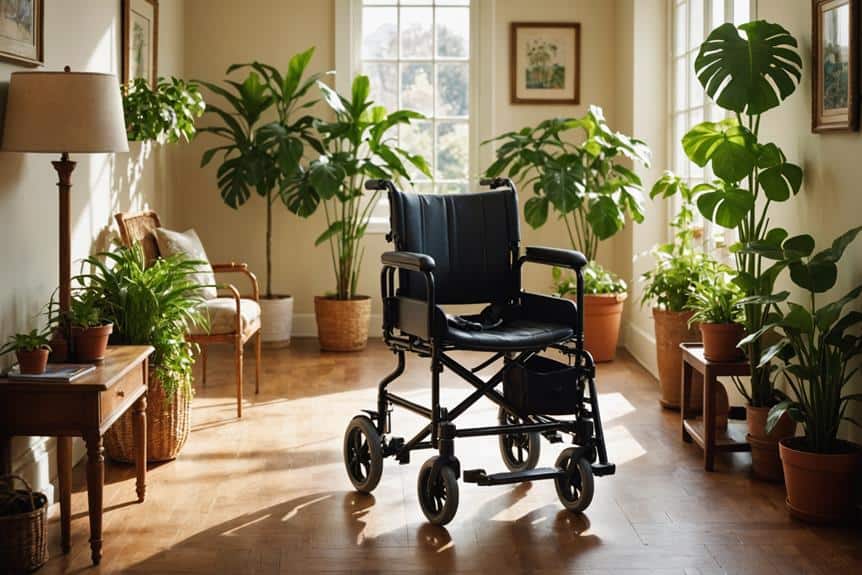Choosing the right mobility aids for seniors is vital for enhancing safety and independence. Start by consulting healthcare professionals, as they can recommend the most suitable devices for individual needs. Consider factors such as weight capacity, adjustability, and the environment where the aid will be used. Options include walkers, manual and power wheelchairs, as well as scooters and hybrid devices. It's also important to explore costs, as insurance and government assistance may help cover expenses. Regular maintenance guarantees your aid remains safe and effective. Discovering tips on selecting and maintaining mobility aids can further improve your experience and well-being.
Importance of Mobility Aids
Emergency departments treat around 3 million seniors each year for fall-related injuries. This staggering statistic underscores the need for assistive devices to mitigate these risks. Even if you haven't fallen before, the fear of falling can be all-consuming. Mobility aids can help alleviate this fear, encouraging you to stay active and engage in physical activities like walking and stretching. Regular movement is essential for maintaining your overall health and well-being.
Types of Mobility Aids
Walkers are another excellent option, accommodating up to 50% of your body weight. They come in various styles, including standard models and wheeled options. Rollators, a specific type of walker, even feature seats so you can rest during use, making them ideal for longer outings.
If you require more support, manual wheelchairs offer additional mobility. They come in standard, lightweight, and ultra-lightweight models, with the latter being customizable to fit your individual needs. For those with limited upper body strength, power wheelchairs provide battery-powered mobility, making it easier to navigate your surroundings.
For users who can't walk long distances, power scooters are designed to help. These require some arm strength to operate and are available in various designs suitable for both indoor and outdoor use. Finally, hybrid devices combine features of mobility aids, like wheelchairs with rollator functions, enhancing versatility and support for seniors with different mobility needs.
Choosing the right mobility aid can greatly improve your independence and quality of life.
Choosing the Right Aid
Consulting healthcare professionals is essential. They can provide personalized recommendations and adjustments to guarantee that the aid fits your height and specific needs. This step is key to achieving the best user comfort, as an incorrectly sized aid can lead to discomfort and even injury. Additionally, exploring options like personalized care approaches can help identify the most suitable mobility aids tailored to individual preferences and requirements.
Consider the environment where you'll be using the aid. For instance, wheeled walkers are ideal for outdoor use, while standard walkers offer greater stability indoors. Think about your daily routines and where you'll need support most.
Next, evaluate the features of various mobility aids. Look for important aspects like weight capacity, adjustability, and additional functionalities such as storage and seating. These features should align with your lifestyle requirements, guaranteeing that the aid serves you well in everyday situations.
Costs and Payment Options
Insurance coverage can play an essential role in managing these expenses. Many health insurance policies require a physician's approval to certify the medical necessity of a mobility aid. Depending on your policy, this coverage can partially or fully offset costs. Programs like Medicare and Medicaid may also provide financial assistance for mobility aids, ensuring you don't bear the full burden of these expenses.
In addition to insurance, several alternatives can help ease costs. Charities such as the Numotion Foundation offer mobility aids at no cost to eligible individuals, ensuring everyone has access to essential equipment. Moreover, various government grants and financial assistance programs exist to support seniors purchasing mobility aids. Some purchases may even qualify for tax relief under specific conditions.
Maintenance and Support Services
As you age, your needs may change, so it's crucial to make periodic adjustments to the height and components of your mobility aids. This guarantees an ideal fit and comfort, allowing you to navigate your environment more easily.
Additionally, access to support services can enhance your experience with mobility aids. Support networks, like local Area Agencies on Aging or community foundations, can provide valuable resources and assistance. These organizations can help you find home care options or assisted living communities, making daily tasks less intimidating.
If you have a mobility aid that shows signs of wear or malfunction, don't hesitate to seek repair tips. Regularly checking wheels, brakes, and other components guarantees safety and prolongs the life of the device.





